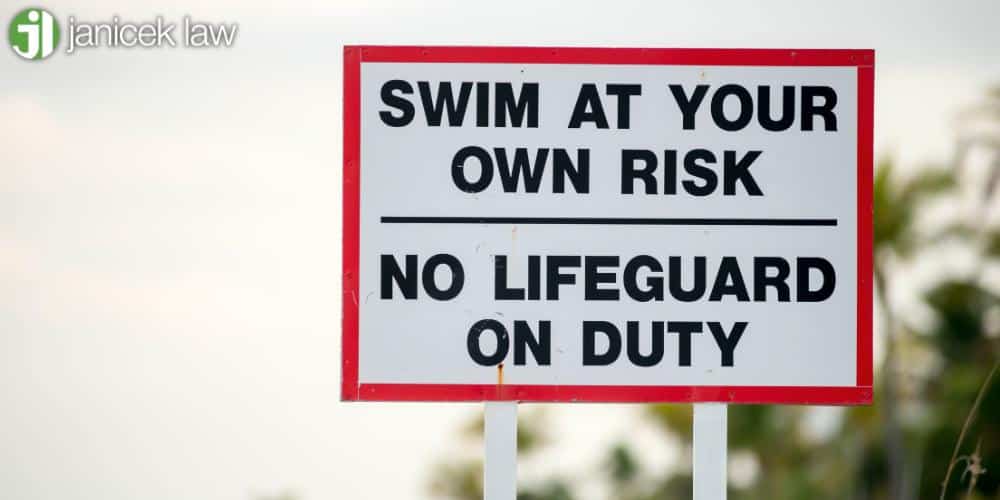When an injured party pursues a personal injury lawsuit, the Texas assumption of risk defense may be used to argue that the plaintiff voluntarily accepted a known risk before the accident occurred. Whether the personal injury case involves a dangerous activity like a baseball game, contact sports, or another dangerous situation, defendants may argue that risk prevents the injured party from seeking compensation. However, the risk doctrine is complex, with primary and secondary assumptions of risk playing different roles. A defendant may claim that a liability waiver, released them from liability, or that the plaintiff knew and accepted a particular risk, leading to the plaintiff’s injury.
Still, proving the defendant’s negligence and a defendant’s breach of this duty element is crucial in determining fault for the plaintiff’s claim.
Because comparative fault, comparative negligence, and plaintiff’s recovery can be affected by this legal doctrine, if you’ve been seriously injured, working with San Antonio catastrophic injury attorneys is essential to ensure that injured victims can still recover damages.
If you sustained a severe injury, call 210-366-4949 for a free consultation to discuss your personal injury case.
Assumption of Risk Definition in Texas
In Texas, assumption of risk is a legal doctrine that may limit a plaintiff’s recovery in a personal injury lawsuit if the plaintiff knew a particular risk existed before engaging in an inherently dangerous activity. The assumption of risk defense argues that the plaintiff knew and understood the risk involved and the plaintiff voluntarily proceeded, which can impact a negligence claim.
There are two main types: primary assumption of risk, where a defendant owes no legal duty to protect against a known risk, and secondary assumption of risk, where the plaintiff knew the risk occurred but proceeded.
While some Texas assumption of the risk cases involve liability waivers, other risk cases depend on proving the circumstances surrounding the injury. Since risk assumption can act as an affirmative defense and a complete bar to compensation, consulting an experienced personal injury lawyer is crucial for understanding how this defense applies to a personal injury case in Texas.
Contact a San Antonio accident lawyer to learn more.
Texas Assumption of Risk Medical Definition
Medical assumption of risk doctrine may reduce an injured person’s recovery if they knowingly accepted risky treatments. However, if a physician’s negligence caused harm beyond this, they can be found negligent in Texas. Since this is not typically a complete bar to compensation, a skilled San Antonio malpractice lawyer can help prove liability and fight for damages.
What is the Assumption of Risk Defense in Texas?
This is a legal defense in personal injury claims that prevents a plaintiff from recovering compensation from negligent defendants because they have proven that the plaintiff knew and engaged in a dangerous activity.
To successfully use the assumption of risk defense in Texas, the defendant must prove:
- The plaintiff actually knew about the risks involved,
- The plaintiff accepted anyway through a written agreement, words, and/or actions.
The assumption of risk defense is a valid legal defense in a personal injury case is because the plaintiff accepted an express assumption or implied assumption in the dangerous activity, so the defendant owes no legal duty. In situations involving the assumption of risk defense, the first element of negligence in Texas – duty of care – isn’t met. The injured person cannot seek compensation for any injuries caused by the inherent risks or the injuries created by the defendant’s breach.
What is the Assumption of Risk Affirmative Defense?
In Texas, an affirmative defense is a legal defense used by a defendant to avoid liability, even if the plaintiff’s claim is valid. Instead of denying wrongdoing, the defendant’s negligence may be excused based on specific legal doctrines, such as the assumption of risk defense, comparative fault, or a liability waiver. This argues that the plaintiff did know the risk existed, failed to take reasonable precautions, or signed a waiver that limited their right to seek damages in a plaintiff’s claim.
Because these defenses can significantly impact a negligence claim, working with experienced attorneys is essential to challenge an assumption of risk defense in Texas.

Assumption of Risk Examples in Texas
For example, a plaintiff pets a dog through a fence despite seeing a “Beware of Dog” sign. The dog bites their hand, and the plaintiff requires an amputation. The plaintiff files a personal injury claim against the owner, and the owner uses the assumption of risk doctrine in their defense, claiming the plaintiff’s injury was a direct result of engaging in a dangerous activity. Therefore, the plaintiff cannot recover damages for their injury.
In such cases, a San Antonio dog bite lawyer or amputation lawyer in San Antonio can help the plaintiff dispute the risk assumption.
Primary vs. Secondary Assumption of Risk
There are two main types of assumptions of risk in Texas: primary and secondary assumptions of risk. Here are the differences between primary and secondary assumptions.
Primary Assumption of Risk in Texas
In Texas, primary assumption of risk applies when a person voluntarily engages in a dangerous activity with understood risks involved. The legal doctrine of primary assumption of risk means that a defendant doesn’t owe any duty element to protect someone from risks occurring naturally.
For example, under the primary assumption of risk, if a person sustains trampoline park injuries in San Antonio, the facility may argue that the person knew that risks occur with trampolines. Since risk assumption was a factor, the personal injury case may be dismissed unless the facility’s breach can be proven under Texas primary assumption of risk laws. A skilled San Antonio premises liability lawyer who understands the primary assumption of risk in Texas can help.
Secondary Assumption of Risk in Texas
In Texas, secondary assumption of risk applies when a person knows that a risk occurs but still proceeds. Unlike the primary assumption of risk, where the defendant doesn’t owe a duty, secondary assumption of risk allows the injured person to pursue a lawsuit, reducing compensation by the percentage of fault. For example, if a passenger knowingly rides with a drunk driver and suffers injuries in a crash, the risk occurring naturally could impact their injury claim. A car wreck lawyer in San Antonio can evaluate the circumstances surrounding the case and help determine how a secondary assumption of risk affects this.
Express vs Implied Assumption of Risk
Texas law recognizes the express assumption doctrine and the implied assumption of risk doctrine.
Express Assumption of Risk in Texas
The Texas express assumption of risk doctrine applies when a person voluntarily accepts a particular risk through a written agreement, such as a liability waiver. These waivers are commonly used in contact sports, baseball games, and even product use, aiming to protect defendants from liability. However, in release provision disputes, courts may examine whether the waiver was enforceable or if an express assumption of risk prevents a claim. For example, if a consumer signs a waiver before using a defective product but later suffers injuries due to a manufacturing defect, the waiver may not be a complete bar under Texas express assumption laws. San Antonio defective product lawyers can help determine whether the waiver is legally valid.
Implied Assumption of Risk in Texas
In Texas implied assumption of risk cases, a person voluntarily encounters a particular risk without signing a waiver, often in particular situations carrying an inherent risk of injury. Unlike express assumption, implied assumption of risk in Texas is typically considered under secondary assumption of risk, meaning it may reduce, but not always act as a complete bar to compensation. For example, if someone walks on a clearly marked wet floor and slips, the defense may argue they knowingly accepted the danger. However, if negligence played a role, a San Antonio slip and fall lawyer can help prove liability.

Release of Liability and Assumption of Risk
A Release of Liability and Assumption of Risk is a written agreement that is often required before engaging in any inherently dangerous activities, such as sports, boating, or even fitness classes. These waivers say two things:
- The participant understands the risk and is choosing to do so anyway.
- That the participant will not sue the business or person who is in charge in the event that they are injured or something goes terribly wrong.
However, under Texas law, signing a release of liability and assumption of risk waiver doesn’t mean the company or person is absolved of negligence. These waivers don’t protect those who are grossly negligent, reckless, or intentionally cause another person harm. Additionally, waivers must be written clearly and easily understood. Many liability waivers are confusing or have sections hidden in fine print, and these won’t hold up in court.
So, such waivers can limit personal injury lawsuits in some situations, but they don’t erase all legal responsibility.
Comparative Fault vs Contributory Negligence
Texas comparative fault laws follow a modified comparative fault system, meaning an injured person can seek compensation as long as they are not more than 50% at fault. Under comparative fault, a plaintiff’s compensation is reduced by their percentage of fault. In contrast, contributory negligence, which Texas does not follow, would completely bar recovery if the plaintiff had any fault in the accident.
Assumption of Risk: Comparative Negligence in Texas
In Texas, risk assumption and comparative negligence can both impact a plaintiff’s ability to seek compensation in a personal injury case. Texas comparative fault laws determine how much compensation a plaintiff can receive based on their share of negligence. If a court finds that the plaintiff is more than 50% at fault, they are barred from recovering compensation. However, if the plaintiff’s fault does not exceed this threshold, their compensation may still be reduced based on their percentage of comparative fault.
How Assumption of The Risk Affects Personal Injury Lawsuits Involving Dangerous Activities
In lawsuits involving dangerous activities, courts consider public policy and the particular situation to determine fault. For dangerous activities, a defendant may argue an express assumption or implied assumption of risk, meaning the person knowingly accepted the hazards. The primary assumption of risk may apply if the defendant had no duty, while waivers may limit responsibility in recreational activities. However, if the defendant is found negligent, the plaintiff can still prove that the injury resulted from unsafe conditions or misconduct. For example, if faulty equipment causes harm despite a liability waiver, the person may still have a valid claim.
Free Consultation for San Antonio Assumption of Risk Cases
If you have suffered serious injuries or lost a loved one due to negligence, you may have the right to pursue a personal injury or wrongful death claim. Our experienced personal injury lawyers and wrongful death attorneys in San Antonio can help you seek justice and compensation. Call 210-366-4949 for a free consultation.

